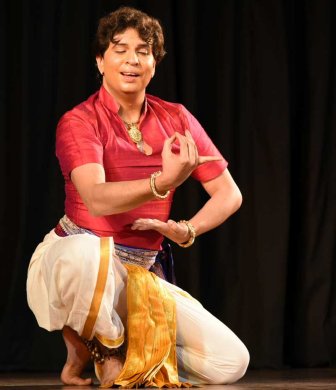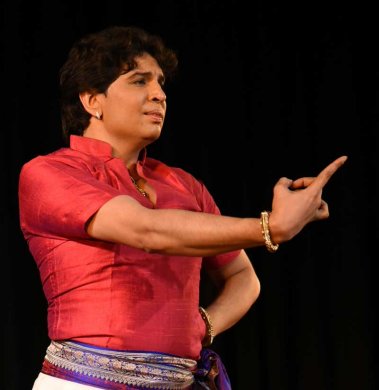
|
 |

|
 |
Aniruddha Knight: Any burden pushes us towards perfection - Shveta Arora e-mail: shwetananoop@gmail.com Photos: Anoop Arora August 8, 2017  Aniruddha Knight is the grandson of the legendary T Balasaraswati, and besides carrying on the dance legacy of the long family line of artists, also carries on their musical legacy as a singer. Aniruddha, trained by his grandmother and mother, divides his time between the US and India. When he performed in Delhi as part of the World Dance Day celebrations organized by Geeta Chandran's Natya Vriksha, I interviewed him about his lineage and style. Explaining his style and bani, he said, "Particularly in Balamma's style, the eye movements and head movements are limited in the nritta. It is felt that the egregious use of drista-bhedha is uncalled for in the nritta as it takes away from the natural flow of the dance and seriousness / complexity of the choreography. The pauses are also taken between ideas in the manodharma - one, to think about the next improvisation, and two, for starting "with a clean slate" of fresh ideas. That pause brings back (the dancer) to the reality of this world instead of the constant world of imagination and creation. The dancer falling out of character at that moment adds stark contrast within the piece, engaging the audience in the moment of creating dance from sahitya." Aniruddha, articulate and expressive, had some strong views about how people perceived the style he performs. Do you feel burdened by your lineage or does it help you push yourself further? Any burden pushes us towards perfection - it's a make-or-break situation. Either you survive or you don't. It's very objective and quite pragmatic that way - either you make it or you don't. And that's how the burden of the tradition works. There are so many different burdens in the tradition. It's to ensure the tradition moves forward by teaching, the burden of performing well each time, because you are carrying the reputation of so many generations before you, and also a personal striving each time to create something new and to do your personal best. They're all burdens, and yes, they move you towards a certain goal. Sometimes you hit it, sometimes you don't. So without that pressure or burdenů you can't make diamonds without pressure, right? Everything needs a burden or pressure to come out in its most beautiful or appropriate way. Why did you start dancing when you did, after having trained in music for so long? No, no, I've been performing since the age of 7. The first I performed was at the Children's Natural History Museum in New York City, and I still remember being paid $150 for it. I'd been performing since then. My arangetram was just as a matter of debut, because I'd wanted that debut. It wasn't something that was necessary within the family, because I was already dancing, but I guess I was at that age that I wanted that. Being a trained singer initially, what was it like to dance? Does it enhance your performance? We saw you singing along during your performance on World Dance Day. I can't dance something without knowing the music because it's only a partial effort then. I feel lost without knowing the music. So you really do need to know the music because so much of the dance comes from the music. Especially in a tradition like this - it is a musical tradition, and the dance resonates from that tradition. Even the nritta part of it has to echo that musicality. It's not as if nritta is different and abhinaya is different - it all begins with that nada, or sound. Everything resonates from that. If you're not in touch with that on a personal level, your dance won't resonate. Sometimes I feel like the music takes a higher priority than the actual lyrics of the song itself, the sahitya itself, because it guides it so much. How many times do you actually understand, as a spectator, the sahitya that's going on? I'm talking as a layman - what you actually are relating to there is the movement itself. That's where..., if you have that gap or pitfall that you can't relate (to the music, you falter)... Humans relate to movement more than anything else. That's where the beauty of the art comes from. And then, of course, there's expressing the ideas and all that, but first, you have to know how to handle movement. That's the most important thing. What is the response like in India, especially Delhi, when you perform here, since it is Chennai that's considered the Mecca of Bharatanatyam? Does everyone understand your particular style of Bharatanatyam? Definitely notů (that Chennai is the Mecca of dance). There were days when Chennai was the Mecca of dance... When you're in Chennai and you're part of the scene, it seems like that's the world of the entire dance scene. But when you step out of it, you realise it's so much more extensive, so much more understanding. In truth, I've become very jaded with the 'dance scene'. And what I do doesn't necessarily fit in with the conventional idea of what Bharatanatyam is about. It's a great uphill battle, because today, audiences expect a package - they know what they're going to get. For example, even the idea of having thematic presentations. When I'm approached by a sabha, once you agree to a concert, the next question is, what's the theme going to be? I don't work that way - each piece is its own theme. You don't necessarily need to set a theme for an entire performance. The complexity and the great colour of the margam itself come from the idea of pieces that are part of a dance performance. I do stick to the traditional format of how it's done, which is not, in a lot of ways, reflected in today's dance scene. Also, what is very different (in the style I perform in) from what is offered today in the Bharatanatyam field, particularly... well, there are a few points. Definitely, of course, the musicality of it, the great emphasis on music, and also the manodharma aspect of it. That's what really makes it a different type of dancing, because nothing is rehearsed. I don't decide what I'm going to be doing, per se, a week before or even a day before the performance. You might want to think about how you might want to take your ideas in a certain direction, but 90% of the time, that decision's right on stage. It's the now, the present; it's creating those ideas to express in the present. You can't rehearse it. Because what is rehearsed doesn't necessarily come from sincerity, according to me. Some days it works and some days it doesn't. That drive, that possibility of failure, is what drives you to say, we're going to try to achieve our best with this today. And that's where this style really does divert from other styles, and also in the nritta aspect, it's very difficult for a lot of people to understand.  The aesthetic of Bharatanatyam has changed nowadays; so much does not come from what the traditional idea of an adavu is supposed to be. A lot of adavus, a lot of movements that are added nowadays are just a matter of convenience and superficial aesthetic. What I come from is a set pattern of adavus that are practised diligently. Even in comparison to other styles of Bharatanatyam, we have 150 adavus of both mai adavu and poi adavu that have a very specific place. And that's what is used as a resource for the nritta. If you know this that a lot of these pieces go on for like 4-5 minutes for the dancers, and how much of those teermanams are done completely in araimandi? Dancers are given the path to move about, to use the stage, to actually stand. But in the traditional format, the entire segment is done in araimandi. So the practicality of being a human being, to be able to do an araimandi for a length of 5 minutes is impractical, in a matter of form. So that's why those teermanams are smaller. Also, the teermanams abide by the rules that are set for how the teermanams should be shaped. For example, all the jathis, the panchajathis, are followed in each varnam. So we will always start out with a trikhala, then a tisram, then misram, then kandam, then sankirnam. And within those jathis, a plethora of teermanams are being used. For example, in a sankirnam, there are 30-40 teermanams that are danced. And many more that are not danced, because we haven't tapped into it. So that gives us a lot of material to work from. Also, the idea that you do it once, and then you move on to something - that's not how it's done. These things are supposed to be performed over and over again - that's how they evolve. Each teermanam almost has its own jiva. And each time you tap into that, sometimes they come to tala and sometimes they don't come to tala. It's also a very precise way of handling tala, because if you look at teermanams, they don't start with sama and end on sama. They end with sama, but they begin with half a beat, a quarter of a beat, one-and-a-half beats, so that's much more complex than just starting the dance. The dancer needs to know her/his calculations, the mathematics of what's happening. The actual teermanam is independent of the varnam. As we use the teermanam, the music does not stop and that adds to the complexity of the teermanam. I'm not trying to be critical of what other people are doing, but it's for people to realise that technically, this is done very differently. Even sitting in araimandi, in the Balasaraswati style, there is no movement of the actual hip itself. You are taught not to sway the hip. It's a much firmer and much more balanced way of dancing, but it's also technically a challenging way of dancing. It's not to pin-point that something is lesser or greater, but just to say that this is the way we do it in comparison to the way it's done now. Contact Aniruddha Knight at: contact@aniruddhaknight.com Post your comments Unless you wish to remain anonymous, please provide your name and email id when you use the Anonymous profile in the blog to post a comment. All appropriate comments posted with name & email id in the blog will also be featured in the site. |